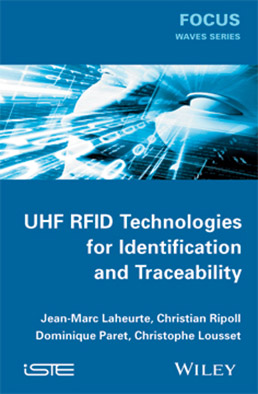
UHF Radio Frequency Identification (RFID) is an electronic tagging technology that allows an object, place or person to be automatically identified at a distance without a direct line-of-sight using a radio-wave exchange. A reference document on the tag antenna design and chip technologies in UHF RFID, this book also includes perspectives on end-users, market and production.
Chapter 1 provides a state of the art in technologies and performances of UHF RFID integrated circuits with a full description of the integrated circuit (IC) functionalities, fabrication issues, matching requirements, measurement tests and benchmarks. This includes a deep analysis of the DC voltage supply generation circuit and its regulator, the demodulator part to recover the data, the on-board oscillator to control the digital part and the organization of this digital part and memory.
Chapter 2 highlights the design and manufacturing issues of RFID tags in environments characterized by disturbances (associated items, other tags, surrounding objects, etc.). Key issues rely on the wideband impedance matching to the RFID IC, and on the tag insensitivity to the environment by considering the dielectric, conductivity and shape features of the tagged item in the antenna design.
Today, backscattering and shunt regulator techniques in RFID are not new but their mutual incidences are not very well known. Chapter 3 provides an excellent and complete overview of this complex subject with the emphasis put on the design methodology as a function of RCS and DeltaRCS with consequences on near-field/far-field communications.
Finally, Chapter 4 focuses on the major topics of future UHF RFID: use of tags throughout the whole product life, smart embedded RFID solutions, seamless and ubiquitous infrastructures, future software in massive networks. It is demonstrated that Return On Investment (ROI) is at the heart of the RFID buying decision process of small intelligent devices.
1. Design and Performances of UHF Tag Integrated Circuits.
2. Design of UHF RFID Tags.
3. The Backscattering Technique and Its Application.
4. RFID Markets.
Jean-Marc Laheurte is Professor at University of Paris-Est Marne-La-Vallée in France where he heads the ESYCOM laboratory.
Christian Ripoll is Associate Professor at the ESIEE Engineering School in France where he teaches RFID and the design of microwave circuits in the ISYS department.
Dominique Paret is the CEO and founder of dp-Consulting. He lectures for several technical schools in France, South Africa and Morocco, and is an experienced author, having written a number of books.
Christophe Loussert is a founder and Vice-President of TAGSYS, a company specializing in RFID solutions. He is responsible for customizing TAGSYS products to fit application-specific requirements